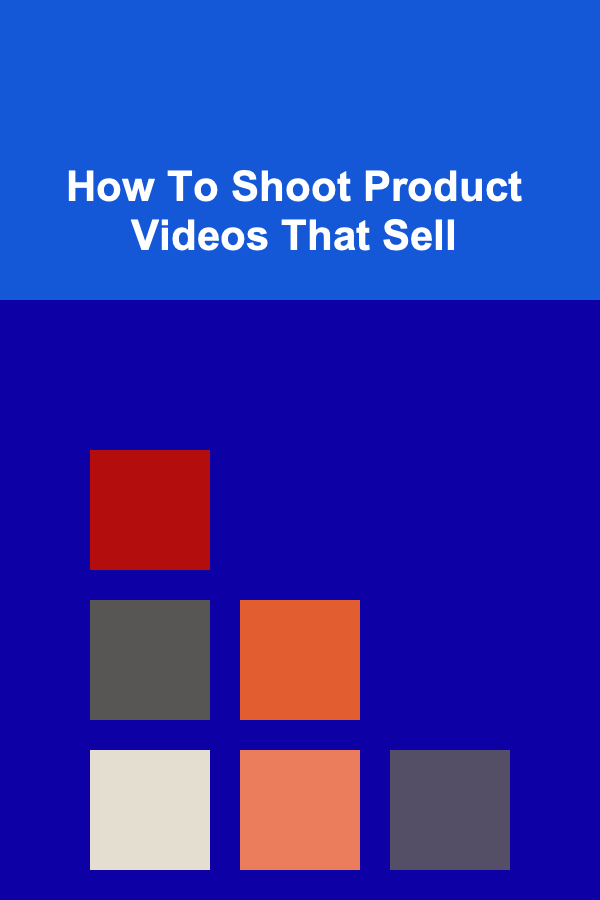
How To Shoot Product Videos That Sell
ebook include PDF & Audio bundle (Micro Guide)
$12.99$9.99
Limited Time Offer! Order within the next:

In today's digital age, creating compelling and persuasive product videos has become one of the most effective ways to engage consumers and boost sales. Video content holds immense power because it blends visual storytelling with a sense of immediacy and tangibility that static images and text simply can't match. In this guide, we'll delve into the best practices for shooting product videos that not only capture attention but also drive conversions.
Why Product Videos Are Crucial for Sales
Before diving into the technical aspects of shooting product videos, it's important to understand why they are so effective in the first place. The shift towards online shopping has changed the way consumers interact with products. In traditional retail, buyers could touch, feel, and examine a product before making a purchase. However, in the digital space, consumers lack that tactile experience, which is where product videos come in.
The Power of Video in Consumer Decisions
Studies consistently show that product videos can significantly increase conversion rates. According to research from Wyzowl, 84% of consumers say that they've been convinced to buy a product after watching a brand's video. Video allows potential customers to see the product in action, demonstrating its features, benefits, and real-world applications. This creates a sense of familiarity and trust, which ultimately helps overcome purchasing hesitation.
Building Trust Through Authenticity
Consumers are more likely to purchase a product when they trust the brand. Authenticity in your product videos plays a huge role in building that trust. It's not just about showcasing a product---it's about showing the product in a real-world context, highlighting its true value, and addressing the customer's pain points. A genuine and informative product video can make a product feel more relatable and human, which is crucial for creating lasting customer relationships.
Key Elements of an Effective Product Video
Creating a product video that sells requires a combination of creativity, technical know-how, and strategic planning. Let's break down the key elements you must focus on:
2.1. Storytelling: Craft a Compelling Narrative
One of the most important aspects of a product video is storytelling. Rather than simply showcasing a product's features, you need to craft a narrative that resonates with your target audience. A compelling story can help potential buyers envision how your product will fit into their lives and solve a problem.
Start by defining the story arc:
- Identify the Problem: Begin by highlighting the problem or need your target audience is facing. This creates context for why they should be interested in your product.
- Present the Solution: Introduce your product as the solution to this problem. Show how the product works and the benefits it provides.
- Call to Action: End with a strong call to action (CTA). Whether it's directing viewers to make a purchase, learn more, or visit your website, your CTA should be clear and motivating.
By weaving your product into a relatable and meaningful story, you can connect emotionally with potential buyers and make them more likely to take action.
2.2. High-Quality Visuals: Crisp, Clear, and Beautiful
The quality of your video's visuals is crucial. Poor lighting, shaky camera work, or low-resolution footage can leave a negative impression on potential buyers. Consumers expect high-quality, professional visuals, and your video should meet those expectations.
Here's how you can ensure your visuals are top-notch:
- Lighting: Lighting is perhaps the most important aspect of a product video. Natural light is ideal, but if you're shooting indoors, use softbox lights or LED lights to ensure the product is illuminated clearly. Avoid harsh shadows or overexposed areas.
- Camera Quality: Use a high-definition camera to capture crisp and sharp visuals. If you don't have access to a high-end camera, many modern smartphones can produce great results as well.
- Background and Composition: Keep the background simple and uncluttered. The focus should be on the product. Use a neutral backdrop or an environment that complements the product to help it stand out.
- Focus and Framing: Ensure the product is in focus at all times, and frame your shots carefully. Use close-up shots to showcase product details and textures, and wide shots to show the product in use.
2.3. Product Demonstration: Show, Don't Just Tell
A product demonstration is one of the most effective ways to convey the value of your product. It allows you to show exactly how the product works, its features, and its benefits. It's much more convincing than simply listing attributes in a voiceover or text.
Here's how to approach product demonstrations:
- Use Real-World Scenarios: Show the product in action in real-life settings. If you're selling a kitchen gadget, demonstrate it being used in the kitchen. If it's a fashion item, show someone wearing it.
- Highlight Key Features: Focus on the features that set your product apart from the competition. For example, if it's a tech gadget, highlight its unique functionalities. If it's a beauty product, demonstrate how it enhances the user's appearance.
- Solve the Problem: Throughout the demonstration, emphasize how the product solves the customer's problem. For example, if your product helps save time, show how it simplifies a task.
2.4. Sound and Music: Enhance the Viewing Experience
Sound plays a significant role in the effectiveness of a product video. A clear and engaging voiceover can provide context and guide the viewer through the features of your product. Additionally, background music can set the tone and mood for the video.
- Voiceover: The voiceover should be clear, friendly, and engaging. Avoid using too much technical jargon or complex language that might confuse the viewer. Keep it simple and conversational.
- Music: Choose background music that aligns with the tone of your brand. For example, upbeat and energetic music might work well for fitness products, while calm and soothing music could suit wellness or beauty products. Ensure the music complements, rather than distracts from, the visuals.
2.5. Length: Keep It Concise
Attention spans are shorter than ever, especially when it comes to online content. Most viewers won't stick around for a 10-minute product video. Aim for a video length of 1 to 2 minutes. This allows you to capture the viewer's attention and convey all the essential information without losing their interest.
Keep in mind that shorter videos also make it easier for viewers to consume and share the content, which can increase the reach of your product.
Technical Considerations for Product Videos
While storytelling and creativity are essential, technical aspects should not be overlooked. Here are some key technical considerations to keep in mind when shooting your product video:
3.1. Stability and Smoothness
Shaky camera work can be distracting and unprofessional. Use a tripod or stabilizer to keep your camera steady during the shoot. If you need to move the camera for dynamic shots, use a gimbal or steadicam to achieve smooth motion.
3.2. Resolution and Framerate
Shoot in the highest resolution possible, ideally 1080p or 4K. This ensures that the video looks sharp on all devices. Additionally, choose a framerate that suits the video's style. A standard 30 fps (frames per second) works well for most product videos, but for slow-motion shots, a higher framerate (60 fps or more) may be appropriate.
3.3. Editing and Post-Production
Editing is where your video comes to life. Use editing software like Adobe Premiere Pro, Final Cut Pro, or simpler tools like iMovie to cut the video, adjust colors, add effects, and insert text. Ensure the video flows smoothly, with each segment transitioning logically into the next. Use overlays or animations to highlight key features of the product.
Make sure the final cut is polished and professional. Even the best shoot can be let down by poor editing.
Optimizing Your Product Video for Different Platforms
Once your product video is ready, it's time to share it. But different platforms require different optimization strategies. Here's how to adapt your video for various online channels:
4.1. YouTube
YouTube is one of the largest video platforms and can be a powerful tool for driving product sales. For YouTube:
- Use an engaging thumbnail to draw in viewers.
- Write a clear, compelling video title and description.
- Include a CTA in both the video and the description to encourage viewers to buy or visit your website.
4.2. Social Media
Social platforms like Instagram, Facebook, and TikTok favor shorter, more visually appealing content. For these platforms:
- Keep videos under a minute, or even shorter, to capture attention quickly.
- Add subtitles for accessibility, as many users watch videos on mute.
- Make use of platform-specific features like Instagram Stories or Facebook's shop feature to drive traffic directly to your product.
4.3. E-commerce Sites
When uploading product videos to your e-commerce site, ensure they are embedded in the product page. Place the video prominently, so it's one of the first things customers see. Include additional details about the product in the video's description and make it easy for customers to add the item to their cart directly from the video page.
Analyzing the Success of Your Product Video
After your product video has been published, it's important to track its performance to see if it's helping you achieve your sales goals. Use analytics tools to measure key metrics such as:
- View count: How many people have watched the video?
- Engagement: How many people liked, shared, or commented on the video?
- Conversion rate: How many viewers made a purchase after watching the video?
By analyzing these metrics, you can identify what's working and what needs improvement. Continuous testing and optimization will help you create more effective product videos in the future.
Conclusion
Shooting product videos that sell is a blend of art and science. It requires creativity, technical skills, and an understanding of your audience. By focusing on high-quality visuals, a compelling narrative, and clear demonstrations, you can create videos that capture attention and drive conversions. With the right strategy, your product videos can become a powerful tool in your marketing arsenal, boosting sales and helping your brand stand out in a crowded digital landscape.

Creative DIY Home Organization Ideas to Maximize Your Space
Read More
How to Make a Spring Cleaning Checklist for Decluttering Your Home
Read More
How to Protect Your Home's Wooden Deck from the Elements
Read More
How to Sell Digital Products Successfully for Social Media Influencers
Read More
How to Stage a Home for a Fast and Profitable Sale
Read More
How to Store Seasonal Decorations Without Overcrowding
Read MoreOther Products

Creative DIY Home Organization Ideas to Maximize Your Space
Read More
How to Make a Spring Cleaning Checklist for Decluttering Your Home
Read More
How to Protect Your Home's Wooden Deck from the Elements
Read More
How to Sell Digital Products Successfully for Social Media Influencers
Read More
How to Stage a Home for a Fast and Profitable Sale
Read More